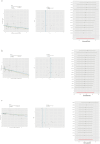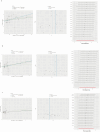Exploring the Relationship Between Immune Cells and Non-Scarring Hair Loss: A Mendelian Randomization Study
- PMID: 38993984
- PMCID: PMC11236941
- DOI: 10.2147/CCID.S467185
Exploring the Relationship Between Immune Cells and Non-Scarring Hair Loss: A Mendelian Randomization Study
Abstract
Background: Non-scarring hair loss (NSHL) is a global health concern with increasing prevalence due to lifestyle changes and an aging population. It can cause psychological distress and affect quality of life.
Objective: This study aimed to identify the associations between NSHL and immune cell phenotypes using a two-sample Mendelian randomization (MR) analysis, offering insights for future immune-based therapies for NSHL.
Methods: We obtained immunocyte data from the IEU Open GWAS Project and NSHL data from the same database and used MR analysis to evaluate the causal association between each immunophenotype and NSHL. Three statistical methods were employed: the MR-Egger regression, weighted median estimation, and inverse variance weighting (IVW).
Results: The MR resonance imaging identified 31 immunocyte phenotypes associated with NSHL. Among these, 19 immunocyte phenotypes were negatively associated with NSHL, indicating their protective effects. The remaining 12 immunocyte phenotypes were positive association. Sensitivity analyses suggested the robustness of all MR findings.
Conclusion: These findings highlight a clear correlation between NSHL and immunity, demonstrating the significant role of certain immune cell phenotypes. This study offers a new direction for immune-based therapies in the treatment of NSHL.
Keywords: Mendelian randomization; immune cell; immunotherapy; non-scarring hair loss.
© 2024 Liu et al.
Conflict of interest statement
The authors report no conflicts of interest in this work.
Figures


Similar articles
-
Investigation of the anti-skin aging effects of taurine through mendelian randomization analysis of its relationship with immune cells.J Cosmet Dermatol. 2024 Dec;23(12):4295-4302. doi: 10.1111/jocd.16515. Epub 2024 Aug 20. J Cosmet Dermatol. 2024. PMID: 39161299 Free PMC article.
-
Complex causal association between genetically predicted 731 immunocyte phenotype and osteonecrosis: a bidirectional two-sample Mendelian randomization analysis.Int J Surg. 2024 Jun 1;110(6):3285-3293. doi: 10.1097/JS9.0000000000001327. Int J Surg. 2024. PMID: 38498404 Free PMC article.
-
Mendelian randomization unraveled: gender-specific insights into obesity-related phenotypes and colorectal cancer susceptibility.Front Endocrinol (Lausanne). 2024 Jun 6;15:1322253. doi: 10.3389/fendo.2024.1322253. eCollection 2024. Front Endocrinol (Lausanne). 2024. PMID: 38904048 Free PMC article.
-
Exploring the causal relationship between interleukin-6 or C reactive protein and malignant melanoma using a two-sample Mendelian randomization approach.Front Oncol. 2024 Jun 17;14:1375362. doi: 10.3389/fonc.2024.1375362. eCollection 2024. Front Oncol. 2024. PMID: 38952546 Free PMC article. Review.
-
Exploring the potential causal relationship between gut microbiota and heart failure: A two-sample mendelian randomization study combined with the geo database.Curr Probl Cardiol. 2024 Feb;49(2):102235. doi: 10.1016/j.cpcardiol.2023.102235. Epub 2023 Nov 30. Curr Probl Cardiol. 2024. PMID: 38040216 Review.
References
LinkOut - more resources
Full Text Sources

